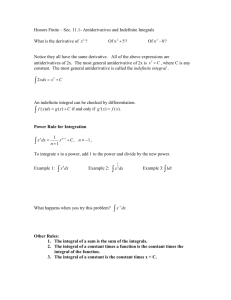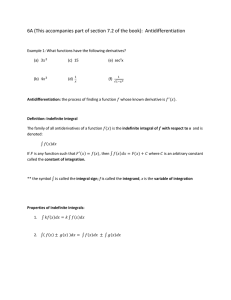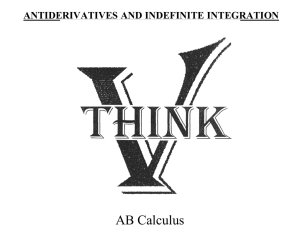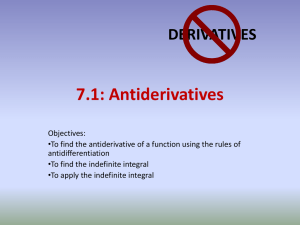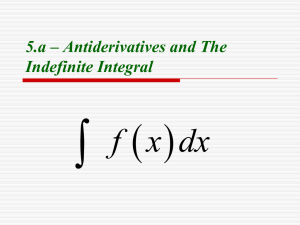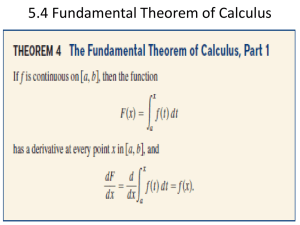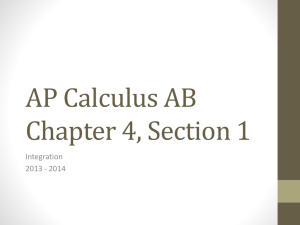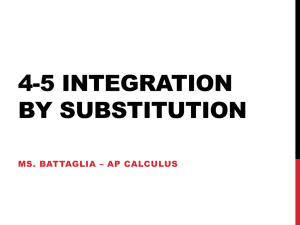CHAPTER FIVE: THE INDEFINITE INTEGRAL AND BASIC
advertisement
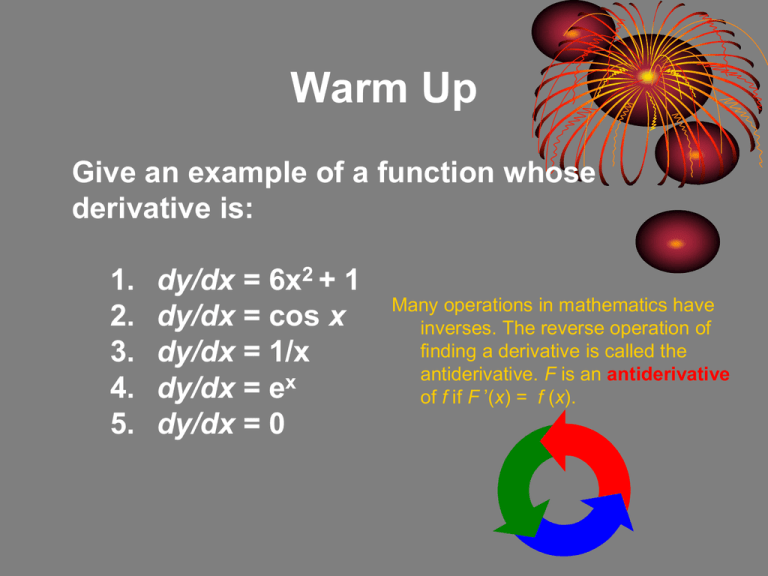
Warm Up Give an example of a function whose derivative is: 1. 2. 3. 4. 5. dy/dx = 6x2 + 1 dy/dx = cos x dy/dx = 1/x dy/dx = ex dy/dx = 0 Many operations in mathematics have inverses. The reverse operation of finding a derivative is called the antiderivative. F is an antiderivative of f if F ’(x) = f (x). CHAPTER FOUR: INTEGRATION • • • • • • • Sect. 4.1 Antiderivatives Sect. 4.2 Area Sect. 4.3 Riemann Sums/Definite Integrals Sect. 4.4 FTC and Average Value Sect. 4.5 Integration by Substitution Sect. 4.6 Numerical Integration and Trapezoidal Rule Particle Motion Sect. 4.1 Antiderivatives and Indefinite Integration • Write the general solution of a differential equation. • Use indefinite integral notation for antiderivatives. • Use basic integration rules to find antiderivatives. • Find a particular solution of a differential equation. Introduction • A physicist who knows the velocity of a particle might wish to know its position at a given time. • A biologist who knows the rate at which a bacteria population is increasing might want to deduce what the size of the population will be at some future time. DIFFERENTIAL EQUATIONS • A differential equation is an equation that contains a derivative. • By antidifferentiating, we can solve this equation for y. x 2 3 x 3 dy 2 3x dx yx 3 3 x 100000000 3 Indefinite Integrals The family of all functions that are antiderivatives of f (x) is called the indefinite integral. Integrand Constant of Integration f x dx F x C Integral Sign Variable of Integration Read: The antiderivative of f with respect to x or the indefinite integral of f with respect to x is equal to….. Some General Rules They are just the derivative rules in reverse. Differentiation Formula d C 0 dx d kx k dx d k f x k f x dx Integration Formula 0 dx C k dx kx C k f x dx k f x dx Some More General Rules Differentiation Formula Integration Formula d f x g x f x g x dx f x g x dx f x dx g x dx Sum / Difference Rule for Integrals d n x nx n1 dx n 1 x x dx n 1 C n Power Rule for Integrals Back to Warm Up Integrate the following: 6 x 2 1 dx 2 x 3 1x c cos x dx sin x c 1 x dx ln x c x x e dx e c 0dx c You Try… Integrate the following. 1. 6a da 6a C 2. dg 3. 3m 4. g C 3m5 5m3 m2 C 4 5m 2 m dm 5 3 2 2 t 1 3 C 1 t dt C 2 2 3 dt 2t t 1 4 3 (z 5. z dz z 1 /2 12 7 4 4z z z 12 3/ 4 2 z C z )dz 12 7 4 7 7 4 C OTHER INTEGRALS THAT SHOULD BE KNOWN cos ax C a sin ax cos axdx C a sin axdx 2 sec xdx tan x C sec x tan xdx sec x C csc x cot xdx csc x C csc xdx cot x C 2 kx e kx e dx k C k x a kx a dx k ln a C dx x ln x C dx 1 x2 arcsin x C dx 1 x2 arctan x C dx x x2 1 arcsec x C Rewriting before integrating x 4 8 x3 1. dx 2 x x 2 8 x dx 3 x 4 x2 C 3 2. 2 x x 3 dx 4 2 x x 3 x 3 x dx 3 c 4 2 You Try… Find the antiderivative. x 1 x 1 1. dx dx x x x 32 2 x 2 x1 2 C x1 2 x 1 2 dx 3 2. ( x 2)( x 3)dx 2 x 3 3x 2 x 6 dx 2 x4 x3 x2 6 x C 4 3. 2 x 5 3x 2 dx 12 x5/2 22 x3/2 20 x1/2 C x 5 3 White Board Practice 1. 2dx 2 x C x2 2. 12( x 1)dx 12 x c 2 1 1 3. 3 dx 2 x 2x u 7 2 4. 3e 2u 6 du u 5. 2 3 3e 7 ln u u 6u C 3 u 7 3 3 3 x x 4 dx x 3x 4 / 3 C 7 4 3 6 3 6. 8 x dx 6 x 12 x C x Day 2 Sect. 4.1 Integration More Integration 1 cos(5 x) 5 sin(5 x) C 1 sin(6 s 9)ds - cos(6s 9) C 6 2. 2t 3. 16e dt 1. 8e 2t C 5x 8 C 4. 85 x dx 5ln 8 2 5. 5 x 9 dx 1 1 5 x 93 1 5 x 93 3 5 15 1 1 1 2 2 xdx 2 x dx dx 6. x 2 x dx 3 x 3x x2 x3 1 2 ln x C 2 3 3 You Try… 9t e 1. e dt c 9 9t 5 3 x4 x2 x x 2. dx c 2 20 6 4 3. (6 x 3 4 x) 2 dx 36 x 6 48 x 4 16 x 2 dx 36 7 48 4 16 2 5 k 2 1 x x x c 4. 2 5 k dk c 7 5 3 ln 2 5 2 7x 2 e7 x 5. e dx ln x c 3x 3 7 Initial Conditions and Particular Solutions When we find antiderivatives, we are creating a family of curves for each possible value of c, called the general solution. 3x C=0 2 y x3 x C=1 y x3 x 1 C=3 y x x 3 3 1 dx x 3 x C When we find the value of C, given a point on y (called an initial condition), we are able to find a particular solution. Example 1 Find the equation of the curve that passes through (2,6) if its slope is given by dy/dx = 3x2 at any point x. 3x dx 2 x3 3 C x 3 C 3 y x C 3 6 23 C C 2 Therefore, y = x3 - 2 Ex 2: Find the general solution of the equation 1 F’(x) = 2 . Then find the particular solution given x the point F(1) = 0. 1 1 2 F ( x ) 2 dx x dx C x x Now plug in (1,0) and solve for C. 0 = -1 + C 1 F ( x) 1 x C=1 You Try… Find the function f (x) for which f x x 2 x and f (1) = 3. x3 2 x3 2 f x C 3 3 13 2 13 2 1 2 1 3 f 1 C C 1 C 3 3 3 3 So, 3 = 1 + C and therefore, C = 2. Therefore, our function is x 3 2 x3 2 f x 2 3 3 You Try… Given: f x x 2 , f 0 6, f (0) 3 Find f(x) Integrate: f x x 2 x3 f x c 3 Substitute x=0 and 6 for f’(0) Thus c = 6 x3 f x 6 3 Integrate again: 1 x4 x4 f x 6 x c 6x c 3 4 12 Substitute x = 0 and f(0)=3 Answer: 03 6 c 3 4 x f x 6x 3 12 04 3 60 c 12 c= 3 Closure • Explain how to integrate x 2x 6 dx x 3 • Explain how to check your answer the problem above. SUMMARY for Integration • A differential equation is an equation that contains a derivative. • You can solve them analytically using integration. • The integral of a derivative is called the antiderivative. Don’t forget to include an arbitrary constant. • There are infinite solutions to a differential equation, but with an initial value you can solve for an arbitrary constant to help you calculate the particular solution. • You SHOULD memorize the table of integrals on pgs. 244 & 391!! In addition, memorizing derivatives are very, very important!
